Our trip was very nice. We didn't expect so much fun, peace and lots of information. Our guide Bolroo was much knowledgeable and very kind. Driver ... was like professional, always carefelly driving out holes on the road.
~ Claudio, ItalyRegister and receive interesting information and travel news
Clothes
If you are going to travel in summer days, it better to put on following clothes: Warm clothes like warm sweater with waterproof and wind protection, warm socks, sturdy hiking boots (for hiking), summer gloves (for riding horses), t-shirt, shirts, trausers, sandals, light rain coat, sunglasses, wide brimmed hat will keep the sun off your face, money belt for your valuables /travelers' cheques, passport and cash/. Sarong or light towels or long shirts are good for avoid indecent exposure when going to toilet in open fields...
|
1. Gobi Desert - Gobi Gurvan Saikhan National Park 2. Middle Gobi Desert- Dundgobi Province 3. Gobi "A" Park- Bayankhongor & Gobi Altai province 4. Eastern Gobi Region- Dornogobi Province |
|
How to get: by jeep: 250-280 kms and 6-8 hours driving
Dund Gobi - Middle Gobi Province area
Middle Gobi area is the semi desert and semi-mountainous area. The area covers a lot of distinguished landscapes with interesting stories and legends such as majestic rocky hill, picturesque oasis, sand dunes, red cliffs, white cliffs, caves. Also this place is the main significant place, where Mongolian historical and cultural heritage is kept among the local people very well. The place is very famous for singers, who sing Mongolian national long songs, people hospitality, temple ruins and rock inscriptions.

Zorgol Khairkhan Mountain and Khagiin lake
Zorgol Khairkhan mountain is located in the distance of 180 km-s south east from Ulaanbaatar. This granite rock high mountain is the sacred one and worshipped by local people every year. According to Mongolian tradition local people refuse to call this mountain name, when they are close to this mountain. It has some springs, and holy peaks, where only men are allowed to reach there. The mountain is very rich with medical plants and mystical stories. There is the beautiful small lake called Khagiin next to the mountain in the east. Local people call it as the Princess lake and it is the main drinking water for the local herds of animals.
Ar Burd Sand dunes
There is Ar burd sand dunes in the 3 km-s of east from Zorgol Mountain. This is the small sand dunes with 2-5 km-s width and length and it is located in vast semi-steppe area. The sand dunes are edged by green grasslands and some trees in the south part.
Baga Gazriin Chuluunii Uul
There are 2 rocky mountains in middle Gobi area and they are called Ikh Gazriin Chuluu and Baga Gazriin Chuluu Mountains, consequently, they are considered as brothers mountains. Baga Gazriin Chuluunii Uul means Small land rocky mountain, and it is elevated at 1768 m above see level, contains a lot of beautiful and unusual view and formation of rocks. The granite rock small mountain is the house for some endangered species of wild animals and for historical places. By the mid of 1750 one Buddhist lama, who was qualified in tantric sect of Buddhism, used to live in this mountain and did meditation in its lovely gorge, that is full of wildflowers and planting birch trees. Also there are some small caves that became the shelter for the Mongolian resistors, who acted against Manju dectature before 1900.
Also this mountain was one of the Mongolian historical places against Manju. In 1690’s Mongolian central and western joint army traveled to this place and had a battle against Manju army, who occupied main China and then conquered to Mongolia. As a result of the battle, still today some arrows and archery details and weapons are found in rocks and there are some of the square shaped burial mounds of the military soldiers, who were killed in that battle. There is one small hole, which is full of rain water and it is used for curing eyes decease. Moreover, There is a few of the rock paintings in some rocks depicting the wild goats and animals. In this mountain if you are lucky, you can see the wild sheep and some gazelles and wolves.
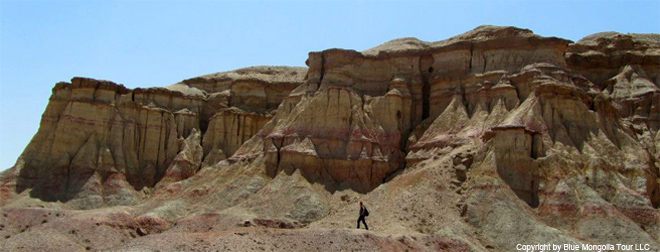
Tsagaan Subarga Cliff
Tsagaan Subarga name is translated like White Stupa, which is given by local people to this impressive and legendary cliff. This 40 meter high white cliff is located in the vast steppe neighboring to another red cliff in west and grassland hills in the north. The cliff was formed approximately 10 millions years ago and it indicates the different colored layers of the soil dated to different times: whitish, gray, yellowish and purple… These colors prove and tell that many millions years ago this place was covered by water and it was big sea. In modern time local people are very keen on the strange formation of this cliff and they have guessing how it was formed and they are still looking for the other part of the cliff. In ancient time the primitive people used this place as hunting place such as making herd of gazelles felling from the cliff edge. By 1990’s Mongolian famous compositor Mr.Jantsannorov visited to this cliff and he has great impression from the colorful view of the cliff and he composed his famous symphony White Stupa. If you are interested, please, listen to this symphony. Click here.
Gallery of Rock paintings in Del Mountain
Del mountain is located in the border of middle gobi and south gobi desert area. Nearly by 40 km long lasting Del mountain is look like a giant dinosaur’s back in the far distance. The rock is resembling like some put it in exact lines and orders and then it was broken into parallel thin slices, some looks like books with many opening pages. Del Mountain is called the natural gallery of rock paintings dated to 3-5B.C. It is housing around 3000 pieces of rock paintings, which is divided into 6 main “galleries’ parts. The paintings are depicting wild animals such as wild goats, deers, yaks, horses, mammoths, lions, wolves, but also person figures, who is hunting, leading the cart, walking, riding horse, having sex and more…. Also this mountain is keeping some numbers of ancient burial mounds.
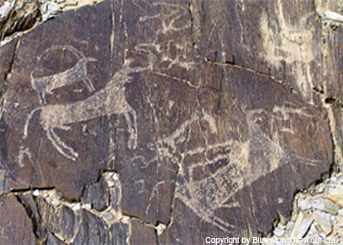
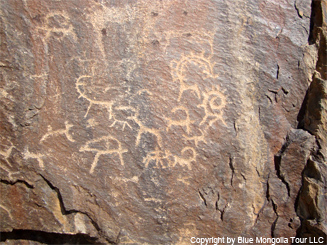
Hevtee Bosoo Cave
The name of this cave is translated into English like Cave for standing and laying. It is around 60 meters long and white colored mud formation cave. In some part it has enough big space for a person to stand and walk free and in some part very tight and narrow pass, where only single person can walk through as lying on the ground. Inside of the cave there is no ice, no water and no crystal, but there some bats are housing inside. It is not allowed to people to enter into this cave during the rain.
Sum Khokh Burd oasis
Sum Khukh oasis is the most luxury oasis in Gobi area. The oasis comprises the small lake, where birds are crowded, and reed covered small forest. There is a tiny island in the middle of the lake. In XVI-XVII centuries a Tibetian lord started to build a big castle with rocks. He was arrested before the castle was not covered with the roof. Although later local people built a roof on the castle several times, the roof was broken down in the thunderstorm. Also there are 40 m long fortress and un-khown building ruins.

Tsogt Prince’s rock inscription
Tsogt Prince, the descendant of Chinggis khan, was not only the high-educated one and very talented man on poem and translation, but he was the best politic man and military leader. He translated many books and established 7 big temples with help of his mother. In the autumn of 1621 during hunting time, he was deeply touched and told 7 stanzas /28 lines/ poem by his heart. After 4 years- in 1625 his soldier carved the poem on the rock. Besides the rock inscription, the rock has numerous rock paintings dated to III-IV B.C.
Ugtaal Sangiin Dalai Temple
Ugtaal sangiin dalai temple is located in Erdenedalai village of Middle Gobi Province. When Tibetan Dalai lama III visited to Mongolia at the first time, Mongolian Buddhist religious leader meet Dalai lama in this place called “Ugtaal”. For this meeting's significance and for an honor of Dalai Lama, Mongolians built a temple in this place. The temple was one of the biggest temples in Mongolia and it kept a lot of valuable books. The temple was destroyed down by purge's period-1935-1940 and then restored again after 1990.
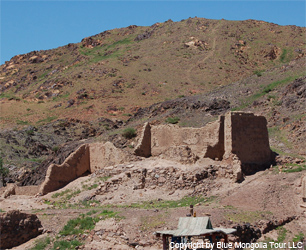
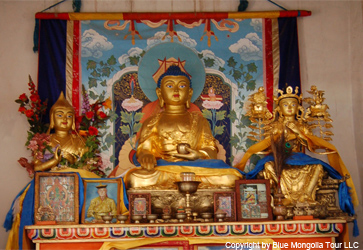
Ongi Monastery Ruins
The ruins of Ongi Temple are found in Saikhan Ovoo soum of Middle Gobi province. It used to be a big Buddhist monastery compound built by Bari Yonzon Khamba Lamaist bishop at the Ongi river, a river that takes source from the Khangai Mountain range. The monastery was built on a steep rocky slope of a mountain in a Nepalese architectural fashion and used to house over a thousand of Buddhist monks. Unfortunately, the Ongi Temple had the same fate of destruction during the communist purges of 1930s as other 700 Buddhist monasteries in Mongolia. In present time local people initaite a project to restore the monastery and rebuild the main temples in that place.
Call our travel expert at:
Tel worldwide: 976-9985 0823, 976-88807160
Tel domestic: 976-70110823
Fax: 976- 7011 0823
Skype: Blue Mongolia Travel agency
Ulaanbaatar Time Now (GMT+7):
Our Office hours is 9:00 to 17:00 Monday to Friday.
Write and send your request at:
info@bluemongolia.com, service@bluemongolia.com
Post address:
Reciepent 99850823, Building 80, Ikh Toiruu Street, Sukhbaatar District, Ulaanbaatar 14192, Mongolia